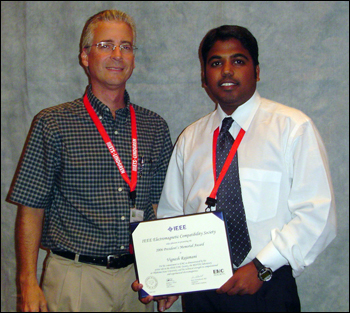Student helps revive electromagnetics course at OSU, receives national honor
Thursday, October 19, 2006

Rajamani received the honor and a $2,000 stipend in August at IEEE’s Electromagnetic Compatibility Symposium in Portland, Oregon.
“The award is great,” Rajamani said. “But the real prize is knowing that my work is appreciated.”
Electromagnetic compatibility is an emphasis of electrical engineering that deals with the development of systems, devices, or equipment that can function properly in their electromagnetic environment without introducing electromagnetic disturbances to anything in that environment.
“The question we try to answer is, will my device, say a cell phone, be able to operate when surrounded by five other wireless devices and still work properly?” Rajamani said. “We try to identify and correct instances of interference so that these technologies work better.”
In 2005, an OSU electrical and computer engineering senior design team constructed a reverberation chamber that simulates real-world conditions for electromagnetic field interactions. The chamber will be used in an advanced, short course on reverberation chamber theory and experimentation the school will offer Nov. 13-17.
The course had not been offered nationally for almost two years, but Charles Bunting, an OSU associate professor of electrical and computer engineering, and Gustav Freyer, a leader in the EMC community, revived it in response to demand from companies such as Lockheed Martin, Cessna Aircraft Company, and Scientific Atlanta, as well as federal agencies including NASA Langley and the Naval Surface Warfare Center.
“The electromagnetic environment is crowded, and the continual emergence of wireless communication devices is making it even more so. But because of this, the future of EMC is bright,” Bunting said. “I believe OSU can be a national leader in the fields of EMC education and testing.”
Rajamani will serve as an assistant instructor for the course.
“My work will deal with the experiments and measurement of the results,” Rajamani said.
After earning his bachelor’s in engineering from the University of Madras in India, Rajamani transferred to OSU, earning his master’s in electrical engineering in 2004.
“Vignesh is Mr. Follow-through,” said Bunting, Rajamani’s Ph.D. adviser. “He is a tremendous asset to our electromagnetic compatibility program and the university.”
Once Rajamani completes his Ph.D., he plans to continue researching in the area of electromagnetic compatibility.
For more information about the Nov. 13-17 short course on reverberation chamber theory and applications held in the REFTAS lab in OSU’s School of Electrical and Computer Engineering, contact Charles Bunting at 405-744-1584.
